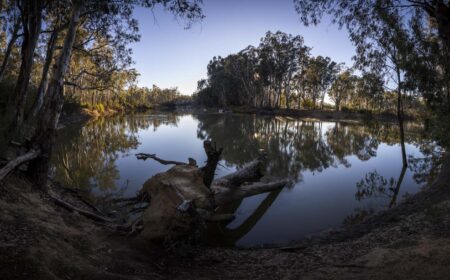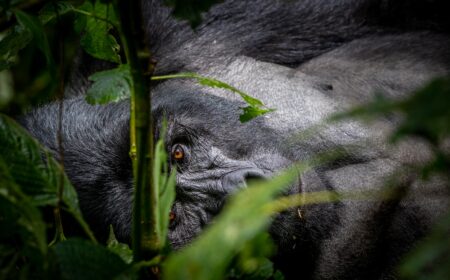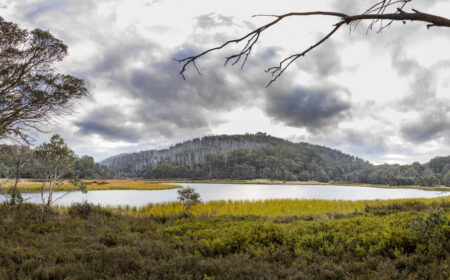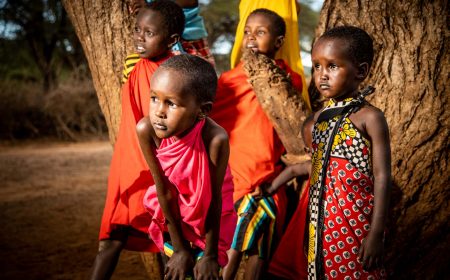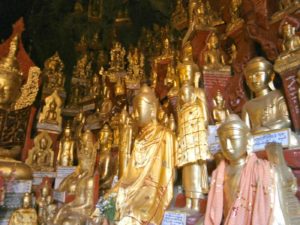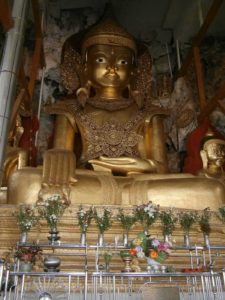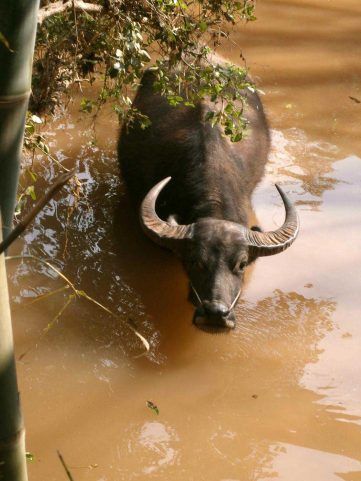Arriving in He Ho, we grabbed a taxi (tried to haggle the price but to no avail), and headed to Kalaw via Pindaya.
Pindaya looks like a lovely town, but we were here to see the caves, which house more than 8000 Buddha images. The caves are quite amazing and it’s bizarre to see so many gold statues tucked in a cave. Just beyond the main cave is a smaller cave housing a 40-foot Buddha, impressive in its own right, but then they light it up – it looks both amazing and a very kitsch.
The walk up to the caves is interesting in itself, but if you don’t feel like walking, you can take a lift up the side of the mountain – yep, you read that correctly! Switzerland may have their cable cars and funiculars, but Myanmar has gone one step further with an elevator.
From Pindaya we headed to Kalaw for an overnight stop. Our only view of the town was from the taxi as we drove through. We stayed at Amara Resort, a beautiful B and B in the mountains and while there was no pool, we did manage to squeeze in a massage.
The following morning we were up early and ready to begin our two-day trek to Inle Lake. The guidebook explained the trek as a cultural/agricultural trek so we expected an urban walk through many towns. In reality there were very few towns, and yet I still somehow managed to pick up a souvenir along the way.
At the first village we came to we stopped for tea and watched an old lady weaving a bag, I bought a hand-woven headscarf from her and delighted the children by having them wrap it around my head.
The village was very traditional, bamboo huts, solar powered energy and pump water, yet when we stopped for tea, they wanted nothing for it; they saw us as their guests. So we paid a little extra for the headscarf to show our appreciation.
The next stop was in someone’s home for lunch. By this time we were absolutely exhausted from the morning’s walk, so we lay on the floor for about an hour while our cook made our lunch. The food was beautiful, and despite being hungry we struggled to eat even a third of the food he had laid out for us. We tried to eat as much as we could as we knew he would be offended, but I’m sure he thought he was cooking for six people, not two.
We walked and walked across the countryside, our guide Koyji pointed out the sights along the way and explained the local way of life to us. Koyji was one of the gentlest souls I have ever met. Just being around him made us feel instantly calm.
We arrived at our final stop for the day, another traditional village, but this one was slightly larger than those we had stopped at earlier. Our cook had gone on ahead by motorbike after lunch to find us accommodation at one of the villager’s homes.
When we arrived at the village we headed straight for the shop for a coke and most importantly to rest our weary legs, while Kojyi went to find the cook. We waited and waited and just when we thought we would be spending the night on the seats in the café, they returned to take us to our home for the night.
Home was a brick and timber house with an outside toilet, no bathroom and an empty room for cooking. We were to sleep in the living room, which housed a Buddha shrine, a sewing machine, a table and a cupboard, no chairs. They had made us a cosy bed of blankets and pillows on the floor.
While our cook made us dinner, we explored the local village, chatting with the children and photographing every day life for a person living in Myanmar.
We ate dinner by candlelight on our balcony – the only chairs in the place, and sat with the male owner of the house. He was in his 70s and had been a monk until his 40s when he met his wife. She was a bit younger, now in her 50s and still had a beautiful smile that lit up her face. When they met, he fell in love and gave up the monastery. They had one daughter who was about 17 years old.
The owners didn’t speak any English, but we were able to work out that he had bad eyes. It was an interesting night’s sleep; Sam spent ages with the torch looking for spiders. And then of course we had to go outside with our torch in the middle of the night to go to the bathroom.
It was quite an unusual experience staying in this couple’s home. We barely saw them and I couldn’t help but feel very humbled that this couple freely opened up their home to us – complete strangers.
We gave them a donation to thank them for letting us stay in their home and the woman blessed us before we were on our way for our second day of walking. Considering how far we had walked the day before, I was surprised we could move, but we managed to continue on.
Kojyi assured us that the second day was easier than the first, but it certainly didn’t feel that way. If anything it felt harder. We had a short break at a roadside shop along with all the other crazy tourists undertaking this trek, and then walked and walked, through valleys and mountains, across the Myanmar countryside. By car the trip would have taken about two hours, it took us one and a half days to walk it, but it was an amazing experience.
Let’s get social. Join @AllAbroadAU on Twitter, Instagram and Facebook for more travel chatter.
